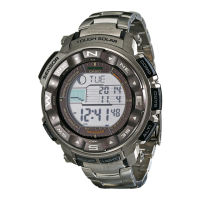Operation Guide 3258
MO1106-EA
E-1
ENGLISH
Congratulations upon your selection of this CASIO watch.
Applications
The built-in sensors of this watch measure direction, barometric pressure, temperature and altitude.
Measured values are then shown on the display. Such features make this watch useful when hiking,
mountain climbing, or when engaging in other such outdoor activities.
Warning !
• The measurement functions built into this watch are not intended for taking measurements that
require professional or industrial precision. Values produced by this watch should be considered
as reasonable representations only.
• The Moon phase indicator and tide graph data that appear on the display of this watch are not
intended for navigation purposes. Always use proper instruments and resources to obtain data for
navigation purposes.
• This watch is not an instrument for calculating low tide and high tide times. The tide graph of this
watch is intended to provide a reasonable approximation of tidal movements only.
•
When engaging in mountain climbing or other activities in which losing your way can create a
dangerous or life-threatening situation, always use a second compass to confi rm direction readings.
• Note that CASIO COMPUTER CO., LTD. assumes no responsibility for any damage or loss
suffered by you or any third party arising through the use of this product or its malfunction.
E-2
About This Manual
• Button operations are indicated using the letters shown in the
illustration.
• Note that the product illustrations in this manual are intended for
reference only, and so the actual product may appear somewhat
different than depicted by an illustration.
(Light)(Light)
E-3
Things to check before using the watch
1. Check the battery power level.
Is “H” or “M” displayed for the battery power indicator (page E-10)?
Go to step 2.
Power is low. Charge the watch by placing it in a location
where it is exposed to light. For details, see “Charging the
Watch” (page E-9).
NO YES
YES
Does any one of the following conditions exist?
• Battery power indicator shows “
L
” and “
LOW
” is flashing on the
display.
• “
C
” is flashing on the display.
• The face is blank.
The watch is charged
sufficiently.
For details about
charging, see
“Charging the Watch”
(page E-9).
NEXT
Battery power
indicator
E-4
2. Check the Home City and the daylight saving time (DST) setting.
Use the procedure under “To confi gure Home City settings” (page E-28) to confi gure your Home City and
daylight saving time settings.
Important!
Proper time calibration signal reception, and World Time Mode and Tide/Moon Data Mode data depend
on correct Home City, time, and date settings in the Timekeeping Mode. Make sure you confi gure these
settings correctly.
3. Set the current time.
• To set the time using a time calibration signal
See “To get ready for a receive operation” (page E-16).
• To set the time manually
See “Confi guring Current Time and Date Settings Manually” (page E-31).
The watch is now ready for use.
• For details about the watch’s radio controlled timekeeping feature, see “Radio Controlled Atomic
Timekeeping” (page E-14).
E-5
Contents
E-2 About This Manual
E-3 Things to check before using the watch
E-9 Charging the Watch
E-13 To recover from the sleep state
E-14 Radio Controlled Atomic Timekeeping
E-16 To get ready for a receive operation
E-18 To perform manual receive
E-21 To check the latest signal reception results
E-21 To turn auto receive on and off
E-23 Mode Reference Guide
E-27 Timekeeping
E-28 Confi guring Home City Settings
E-28 To confi gure Home City settings
E-30 To change the Daylight Saving Time (summer time) setting
E-31 Confi guring Current Time and Date Settings Manually
E-31 To change the current time and date settings manually
E-6
E-34 Taking Direction Readings
E-34 To take a digital compass reading
E-37 To perform bidirectional calibration
E-38 To perform northerly calibration
E-39 To perform magnetic declination correction
E-40 To store a direction angle reading in Bearing Memory
E-42 To set a map and fi nd your current location
E-43 To fi nd the bearing to an objective
E-44 To determine the direction angle to an objective on a map and
head in that direction (Bearing Memory)
E-47 Taking Barometric Pressure and Temperature Readings
E-47 To enter and exit the Barometer/Thermometer Mode
E-47 To take barometric pressure and temperature readings
E-53 To calibrate the pressure sensor and the temperature sensor
E-55 Taking Altitude Readings
E-56 To take an altimeter reading
E-58 To select the altitude auto measurement method
E-59 To specify the altitude differential start point
E-60 To use the altitude differential value
E-61 To specify a reference altitude value
E-62 To save a manual measurement
E-7
E-70 Specifying Temperature, Barometric Pressure, and Altitude Units
E-70 To specify temperature, barometric pressure, and altitude units
E-72 Precautions Concerning Simultaneous Measurement of Altitude and Temperature
E-73 Viewing Altitude Records
E-73 To view altitude records
E-76 To clear the contents of a specifi c memory area
E-77 Viewing Tide and Moon Data
E-78 To enter the Tide/Moon Data Mode
E-79 To view Moon Data for a particular date, or Tide Data for a particular date and time
E-80 To adjust the high tide time
E-81 To reverse the displayed Moon phase
E-86 Using the Alarm
E-86 To enter the Alarm Mode
E-87 To set an alarm time
E-88 To turn an alarm and the Hourly Time Signal on and off
E-88 To stop the alarm
E-89 Using the Stopwatch
E-89 To enter the Stopwatch Mode
E-89 To perform an elapsed time operation
E-89 To pause at a split time
E-90 To measure two fi nishes

